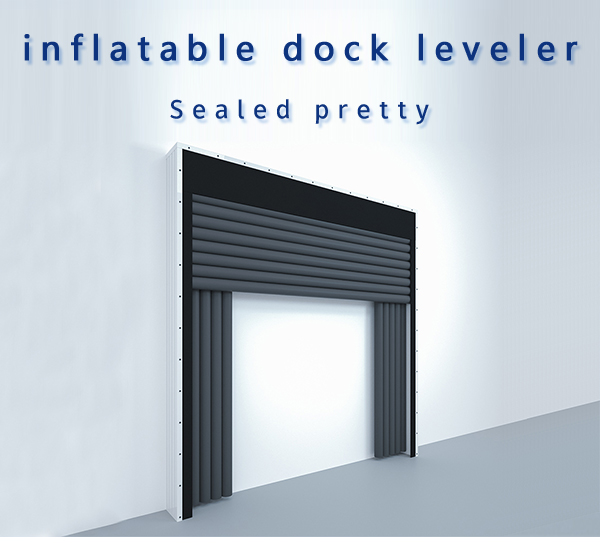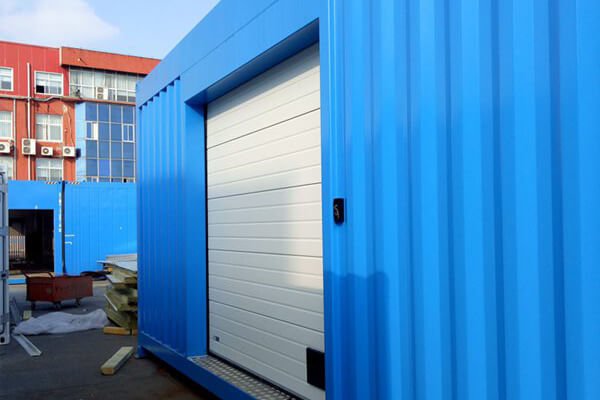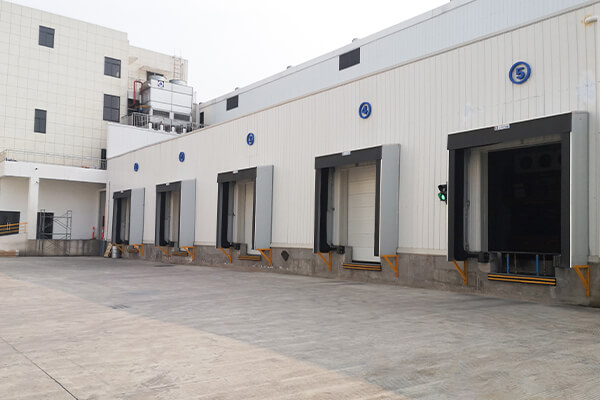
Warehouse Loading Dock is one of the crucial links in the warehousing business. It is a key node in the flow of goods, which directly affects the efficiency of warehousing and operational processes. This article will discuss the design and management of Warehouse Loading Dock. It focuses on key equipment such as loading dock leveler, sectional and loading dock shelter. Help you better understand how to optimize the warehousing process and improve operational efficiency.
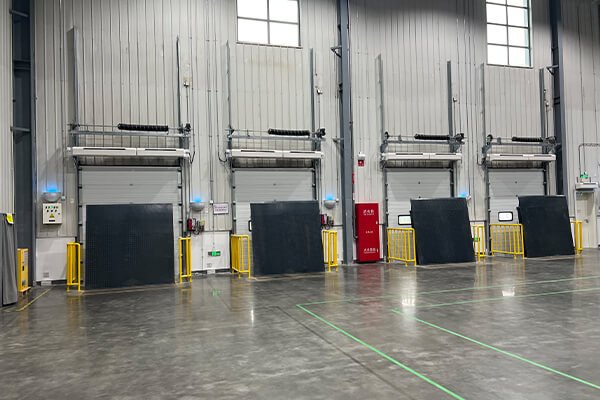
Importance and Role of Warehouse Loading Dock
Key Node of Goods Circulation: Warehouse Loading Dock is one of the key nodes of goods circulation, responsible for loading, unloading and transshipment of goods. It connects the internal storage area of the warehouse with the external transportation vehicles. It plays the role of a bridge. Ensure the smooth flow of goods.
Improve loading and unloading efficiency: Through rational design and management of Warehouse Loading Dock, loading and unloading efficiency can be effectively improve. Optimized loading and unloading channel layout, efficient loading and unloading equipment and scientific workflow. Can save time and labor costs. Improve the efficiency of warehousing operations.
Ensure operational safety: The safety of Warehouse Loading Dock is crucial for warehousing operations. Reasonable setup of safety facilities, provide the necessary safety training and standardize the work process. Can reduce the safety risks in loading and unloading operations, to protect the safety of operating personnel and equipment.
Realize the seamless connection of logistics and distribution: Warehouse Loading Dock is an important node of logistics and distribution, which directly affects the speed and efficiency of logistics and distribution. Through reasonable loading and unloading layout and efficient loading and unloading operations. Can realize the seamless connection of logistics and distribution. Ensure that the goods are delivered to the destination in time and accurately.
Enhance customer satisfaction: Efficient operation of warehouse loading and unloading area can enhance customer satisfaction. Timely and accurate completion of loading and unloading operations to ensure that the goods are intact and arrive in time. It can enhance the customer’s trust and satisfaction of the service and promote the establishment of long-term cooperative relationship.
Dock Leveler: improving loading and unloading efficiency

Definition
The hydraulic dock leveler is an indispensable piece of equipment in the Warehouse Loading Dock. It provides a solid working platform for easy loading, unloading and handling of goods. Loading Dock Leveler is suitable for fixed loading and unloading points, while Mobile Loading Dock is suitable for temporary loading and unloading needs. In addition, the Hydraulic Lift Platform can adjust different heights of trucks. It improves the loading and unloading efficiency.
Role and function of Dock Leveler
Provides access for loading and unloading: The loading and unloading platform provides a smooth working platform. It connects the internal storage area of the warehouse with the external transportation vehicles. As part of the loading and unloading aisle, the loading platform enables goods to be smoothly loaded from inside the warehouse to the transportation vehicle. Or unloaded from the transportation vehicle into the warehouse.
Simplifying the loading and unloading process: The loading dock leveler facilitates the loading and unloading process, making it easier and more efficient. Staff can operate from the loading platform. There is no need to climb up to the transportation vehicle or to load and unload from the ground. This greatly reduces the labor intensity and time cost of the loading and unloading process.
Improve operational efficiency: As the hydralic dock leveler provides a solid working platform. Loading and unloading operations can carry out more quickly and safely. Reasonably designed loading and unloading channel layout and efficient loading and unloading equipment can further improve operational efficiency. Save time and labor costs.
Ensure operational safety: The smoothness and safety of the dock leveler is crucial to the safety of loading and unloading operations. A well-designed dock leveler can prevent goods from slipping and people from danger. Provide a safe working environment. Safeguard the safety of operators and equipment.
Adapt to different heights of transportation vehicles: Different types of transportation vehicles may have different heights. The dock leveler can adjust in height as needed. To adapt to different heights of transportation vehicles. This flexibility and adjustability makes the hydraulic dock leveler suitable for all types of loading and unloading requirements.
Different types of dock levelers and features
Loading Dock Leveler
It is installed on the cargo platform. It is horizontal to the warehouse platform and completely integrated in the platform. One of its great advantages is that when there is no loading and unloading operation, it will not affect other operational tasks on the platform. Convenient to store and use, but also the use of a wide range of dock leveler. However, it needs to be well planned as early as in the structural design of the building. Because of the need to reserve the pit structure in advance.
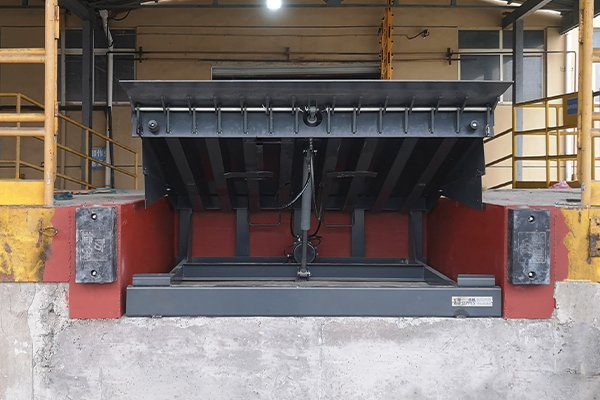
Mobile Loading Dock Leveler
It is widely used in cargo platforms without loading and unloading equipment and mobile loading and unloading places. It is the auxiliary equipment for cargo loading and unloading used in conjunction with forklift trucks. With the help of this bridge equipment, forklift can directly drive into the car compartment for batch loading and unloading operations. The big feature of mobile unloading platform is that it is easy to move. Used for wider places, not applicable to smaller places.
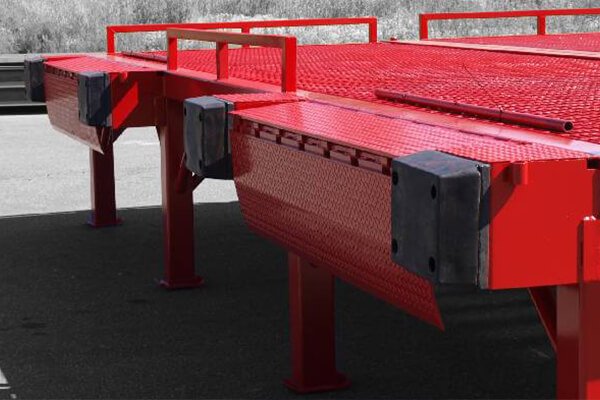
Hydraulic Lift Platform
It adopts double-mast structure with large load capacity and large platform area. It is stable, flexible in operation and easy to implement. With its light appearance, it can exert the highest lifting capacity in a very small space. The Hydraulic Lift Platform is suitable for factories, hotels, buildings, shopping malls, stations, airports, stadiums and so on. It can be used as installation and maintenance of power lines, lighting appliances, overhead pipelines and so on. Aerial cleaning and other aerial work of single person working.
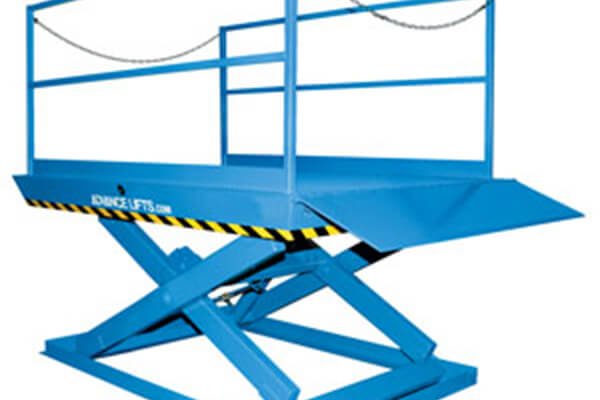
Sectional Door: safe and efficient loading and unloading access
Definition
The sectional door is an essential part of the Warehouse Loading Dock. It provides safe and efficient access for loading and unloading, avoiding the risks and delays associated with manual handling. Vertical sectional doors are suitable for locations with limited heights. Horizontal sectional doors, on the other hand, are suitable for situations where large amounts of goods need to move sideways. In the selection and installation of sectional door. Need to consider the actual situation of the storage place and operational needs.
Working principle and advantages of sectional door
The design principle of industrial sectional doors is to install the track as close as possible to the inside of the building. This saves a lot of space inside the building. Depending on the size and shape of your building, panel lift garage doors can be designed to be installed in different ways. The choice of door lifting method can be based on the following basic conditions: door opening size; door opening upper space; door opening side space; door opening depth. According to the actual situation of the building site, combined with the owner’s side of the use of space requirements. The following lifting methods can be realized to maximize the requirements of reasonable use of space.
1、Standard lifting: applicable to the door top space in: 200-300mm or less.
2、High lifting: applicable to the door top space in: 〉300mm〈door opening height
3、Vertical lifting: applicable to the door roof space: > or = door opening height
4、Sloping roof lifting: applicable to the shape of the slope of the ceiling of the door roof. Track and ceiling into a parallel state.
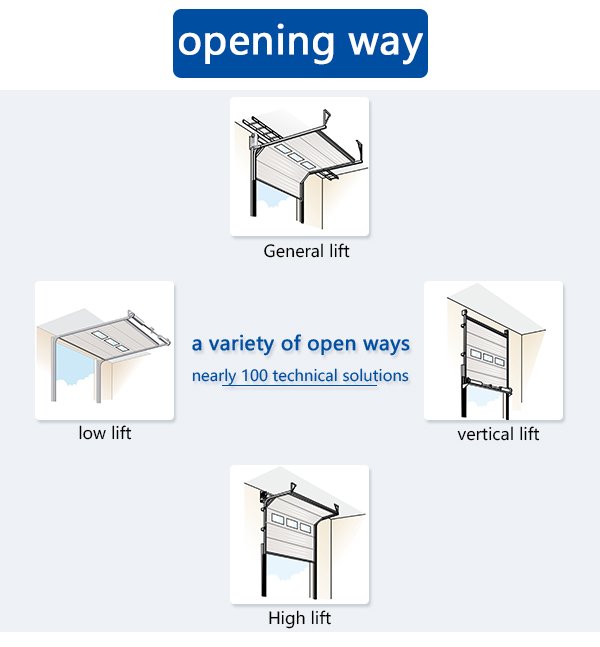
Vertical sectional door application scenario
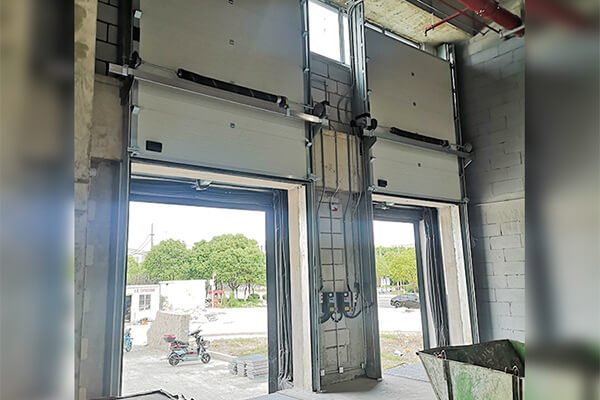
Standard sectional door application scenario
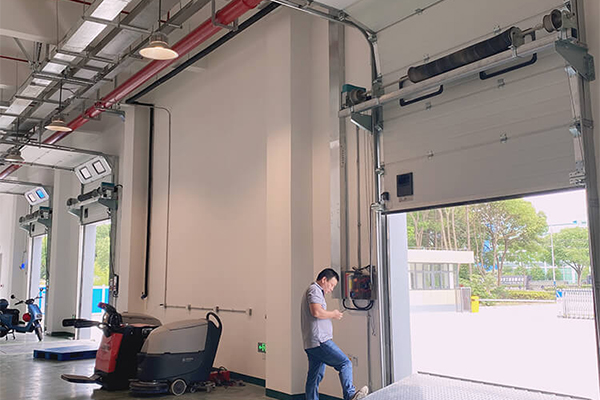
Sectional door selection and installation
Selection of sectional door
Operational requirements: First of all, you need to consider the specific operational requirements of the warehouse or logistics center. This includes the type and frequency of loading and unloading, as well as the operational process. Different industrial sectional doors are suitable for different scenarios. For example, vertical industrial sectional doors are suitable for places with limited height. Horizontal sectional doors are suitable for situations where goods need to be moved horizontally.
Carrying capacity: The carrying capacity of the sectional overhead door is one of the key factors in the selection process. You need to make sure that the sectional overhead door you choose is capable of carrying the weight of the goods to be loaded and unloaded. It should also have adequate safety measures.
Size and space: The size and space of the sectional garage door should match the actual situation of the warehouse or logistics center. The height, width and installation position of the sectional overhead door need to be considered. To ensure that the loading and unloading operations can be carried out smoothly and does not affect the smooth operation of the aisle.
Safety: When choosing a sectional door, consider its safety features. High-quality sectioanl door should have a safety sensing system, anti-collision devices and emergency stop button and other safety features. To ensure the safety of operators and equipment.
Installation of sectional door
Professional Installation: Installation of an industrial sectional door should carry out by a professional or technical team. This ensures a smooth installation process and compliance with relevant safety standards and regulations. During installation, attention needs to be paid to the fixing and balancing of the sectional door. The door should be secured and balanced during the installation process, as well as securely attached to the structure of the warehouse.
Location: The installation location of the sectional overhead door should be determined according to the actual operational requirements and warehouse structure. Need to take into account the path of goods flow, the smooth operation of the channel and the setup of safety protection facilities. Ensure that the installation location of the liftgate can maximize operational efficiency and safety.
Power and control system: When installing the sectional overhead door, it is necessary to ensure that there is an adequate power supply and a stable control system. The door usually needs connecting to the power and control system. To realize the opening and closing of the door, adjust the height and other functions. Therefore, it is necessary to ensure the stability and reliability of the power and control system.
Maintenance: After the installation is completed, regular maintenance is the key to ensure the long-term stable operation of the door. You need to regularly check the components and functions of the sectional door. Timely detection and resolution of potential problems, to extend the service life of the sectional overhead door and ensure operational safety.
When selecting and installing the sectional door , you need to consider the operational requirements, safety performance, space conditions and other factors. And after the installation is over, regular maintenance will carry out to ensure that the sectional overhead door can operate safely and efficiently.
Dock Shelter : Environmental Protection and Operational Efficiency
Definition
Dock Shelter for loading and unloading plays an important role in protecting the working environment and improving operational efficiency. Different types of door seals. Such as mechanical dock shelters, sponge dock shelters and inflatable dock shelters. They can effectively prevent the influence of external factors such as temperature, humidity and dust. Choosing the right loading dock seals for loading and unloading needs to consider the characteristics and needs of the operating environment. And regular maintenance and cleaning should carry out to ensure its normal operation.
Different types of loading dock shelters and features
Mechanical dock shelter
Mechanical dock shelter plays a good role in sealing the space between the vehicle and the warehouse. Canopies are made of wear-resistant, tough fiber material can not only completely close the perimeter of the truck or container. It can also withstand strong wind pressure, and the loading and unloading canopy can also withstand strong snow pressure. Play the role of windproof, rainproof, dustproof and blocking the external hot air to save the internal cold air of the refrigerator. And it improves the working environment and also helps energy saving and running operation in the warehouse.
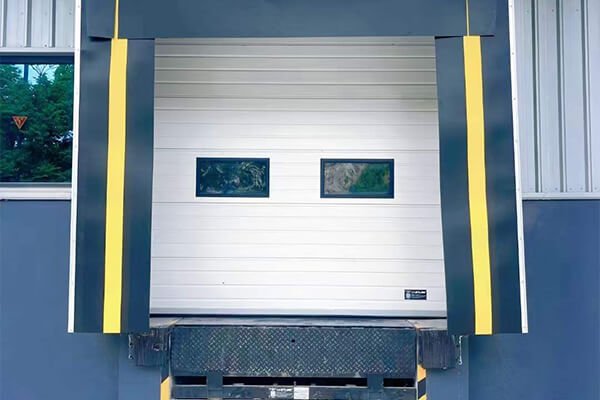
Sponge Dock Shelter
Sponge dock shelters are made of polyester monofiber elastic strength fabric with PVC coating. The interior is filled with a high elasticity performance foam with a maximum compression ratio of 73%. The fabric is fastened with screws and metal grommets, which always ensure an even flow of air under pressure. The pleated pages are distributed on both sides and above and are resistant to abrasion and extrusion.
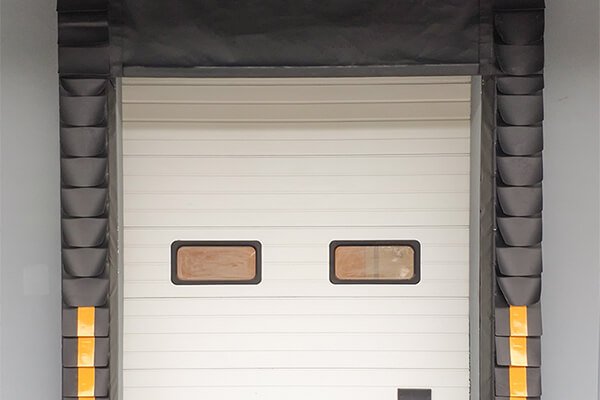
Inflatable Dock Shelter
The surface of inflatable dock shelter is made of high quality neoprene fiber rubber with high wear-resistant material, which can meet the service life of not less than 30,000 times. The airbags on both sides and the top of the door are inflated to securely wrap the rear part of the compartment. The two side airbags adopt L-shape structure to ensure a tight seal between the bottom of the two side airbags and the wall. The width adjustment range is up to 1600mm and the length adjustment range of the top airbag is 1200~1500mm, which is suitable for all kinds of truck chassis height.
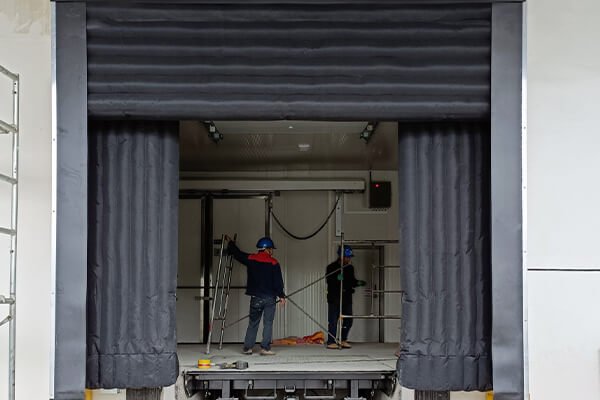
How to choose the right dock shelter for loading and unloading
Operating environment: First of all, you need to consider the characteristics of the operating environment, including temperature, humidity, wind speed and other factors. For high or low temperature environment, you need to choose high temperature or cold-resistant dock seals;For the environment of high humidity, you need to choose waterproof and moisture-proof dock door seals;For environments with high wind speed, you need to choose door seals that can effectively resist wind.
Cargo type: Different types of goods have different requirements for dock shelters. For example, goods that are susceptible to contamination may require tighter dock shelter to protect the goods from dust and pollutants. Corrosive goods may require corrosion-resistant seals to extend the shelf life of the goods.
Frequency of Operation: Frequency of operation is an important consideration in the selection of dock shelter. For places with high frequency of operation, such as logistics centers or warehouses, the dock shelter needs to be selected. Such as logistics centers or warehouses, you need to choose wear-resistant, durable door seals to ensure stable operation for a long time.
Safety requirements: Operational safety is one of the most important considerations. Warehouse dock door seals should equip with safety protection functions. Such as anti-collision device, safety sensing system, etc.. To ensure the safety of operators and equipment.
Size and Adaptability: When selecting a loading dock shelter, it is necessary to consider its size and adaptability to the Warehouse Loading Dock. The size of the dock shelter should match the size of the loading dock. Ensure that the door seal effectively closes the loading dock. Protect against outside elements such as temperature, humidity and dust.
Precautions for loading dock seals installation and maintenance
Installation Notes
Professional Installation: The installation of the dock shelter should carry out by a professional technician or an experienced installation team. They should have the relevant technical knowledge and operational experience. Ensure that the installation of the door seal carry out smoothly and in accordance with relevant safety standards and regulations.
Positioning: The dock shelter needs to be installed in the right place. Ensure that the door seal can effectively seal off the loading and unloading aisle and prevent intrusion by outside elements. Take into account the size of the aisle, operational needs and safety requirements. The location of the door seal should be determined appropriately.
Stable fixing: After the dock shelter is under installation , make sure it is firmly stationary on the floor or wall, and not easy to move or shake. Use high-strength bolts or fixing devices to ensure that the dock shelter is firmly and reliably connected to the floor or wall.
Power supply: For dock shelter that require power supply, such as motorized dock shelter, it is necessary to ensure that there is a stable power supply. Pay attention to the laying and connection of cables during installation. Ensure that the power supply lines are safe and reliable.
Safety protection: When installing the loading dock shelter, it is necessary to consider its safety protection function. The dock shelter should equipwith anti-collision device, safety sensing system and other safety features to protect the safety of operators and equipment.
Maintenance Notes
Periodic Inspection: Periodically inspect the functions and components of the loading dock seal. This includes the opening and closing functions of the door seal, the operating status of the mechanical components, and the effectiveness of the safety devices. Timely detection and resolution of potential problems to ensure the normal operation of the door seal.
Cleaning and maintenance: Regularly clean and maintain the door seal, remove the accumulation of dust, debris and oil. Keep the appearance of the door seal tidy and running smoothly. Especially for the sealing parts, regular cleaning and lubrication is needed to ensure its normal sealing effect.
Parts replacement: For parts that are badly worn or damaged. Such as springs, rollers, stoppers, etc., need to be replaced in time. Choose original parts or qualified replacements to ensure the operational stability and safety of the loading dock door seals.
Operational specification:Employees should be trained and instructed in the operation of the dock shelter, use the door seal correctly and follow the operating procedures. Do not alter the dock seals or carry out unauthorized maintenance to avoid unnecessary damage or safety hazards.
Regular Maintenance Records: Establish regular maintenance records for dock shelters, recording information such as maintenance content, time and responsible personnel. Through the management of regular maintenance records. Timely detection and resolution of door seal problems to ensure its long-term stable operation.
Best Practices and Case Studies
There are some best practices that can refer to in the design and management of Warehouse Loading Dock. For example, rationalize the location and number of loading docks. Selecting suitable sectional doors and dock seals, as well as enhancing the maintenance and management of the equipment. Through case study. We can learn how some successful warehousing companies utilize the loading dock system to improve efficiency and reduce costs.
Frequently Asked Questions (FAQs)
A. What factors should be considered in the design of a Warehouse Loading Dock?
The height of the loading platform, the type of liftgate, and the type of loading dock seal all need to be considered to ensure smooth and safe operations.
B. What is the purpose of a loading dock seal?
Loading and unloading door seals can prevent the influence of external factors such as temperature, humidity and dust, protect the operating environment and improve operating efficiency.
C. How to choose the loading and unloading platform suitable for your storage place?
You need to consider the type of truck, frequency of operation, site conditions and other factors. Choose the loading and unloading platform suitable for your storage place.
